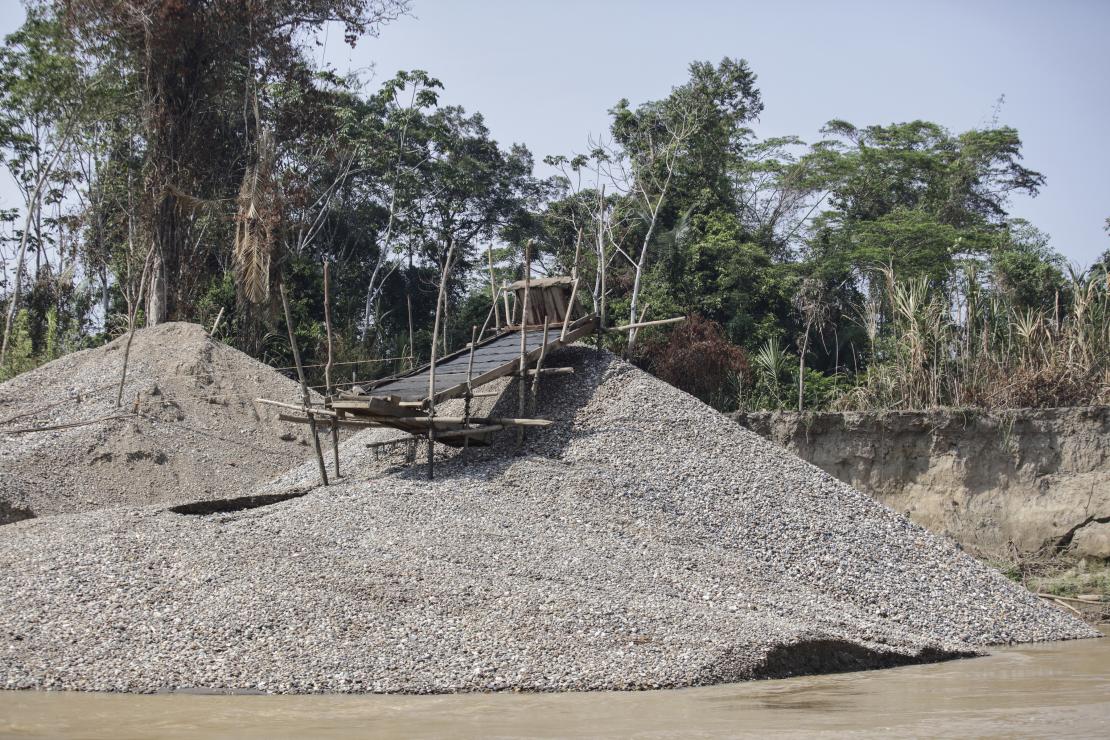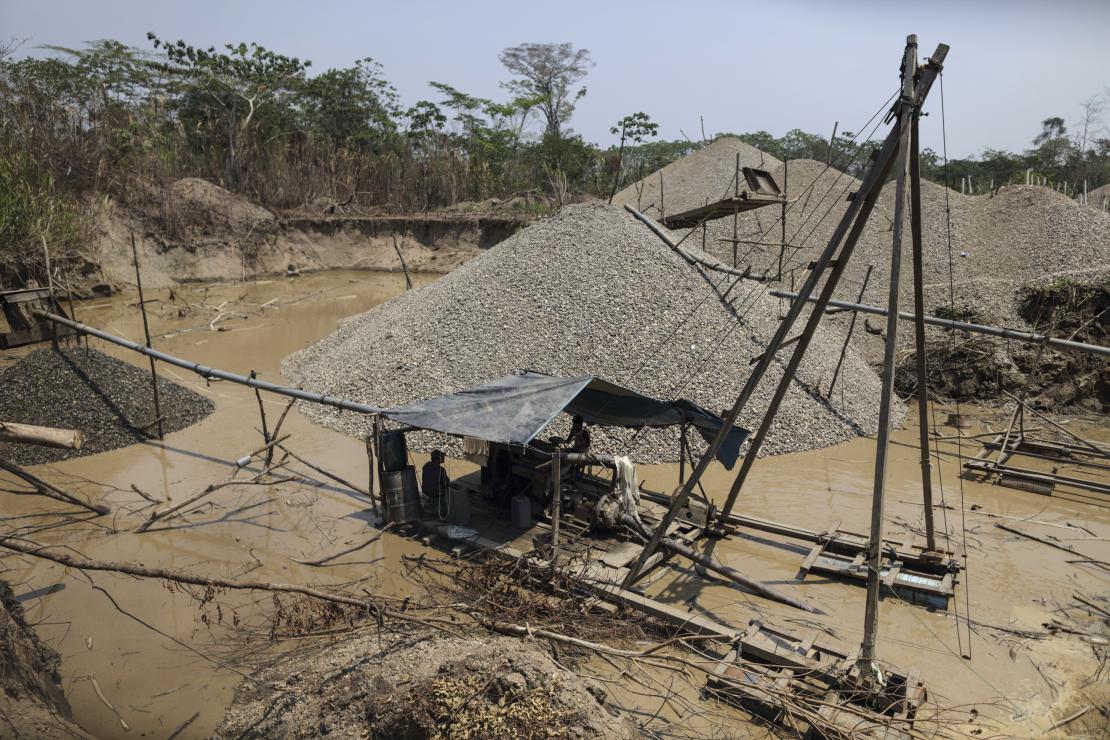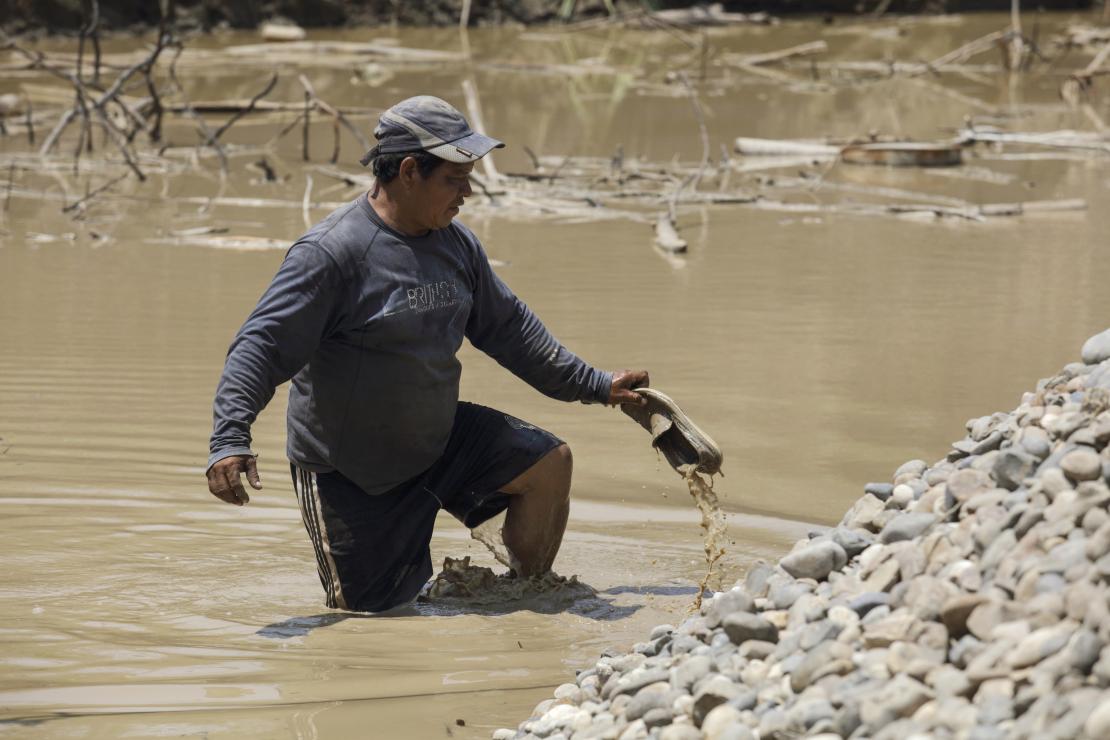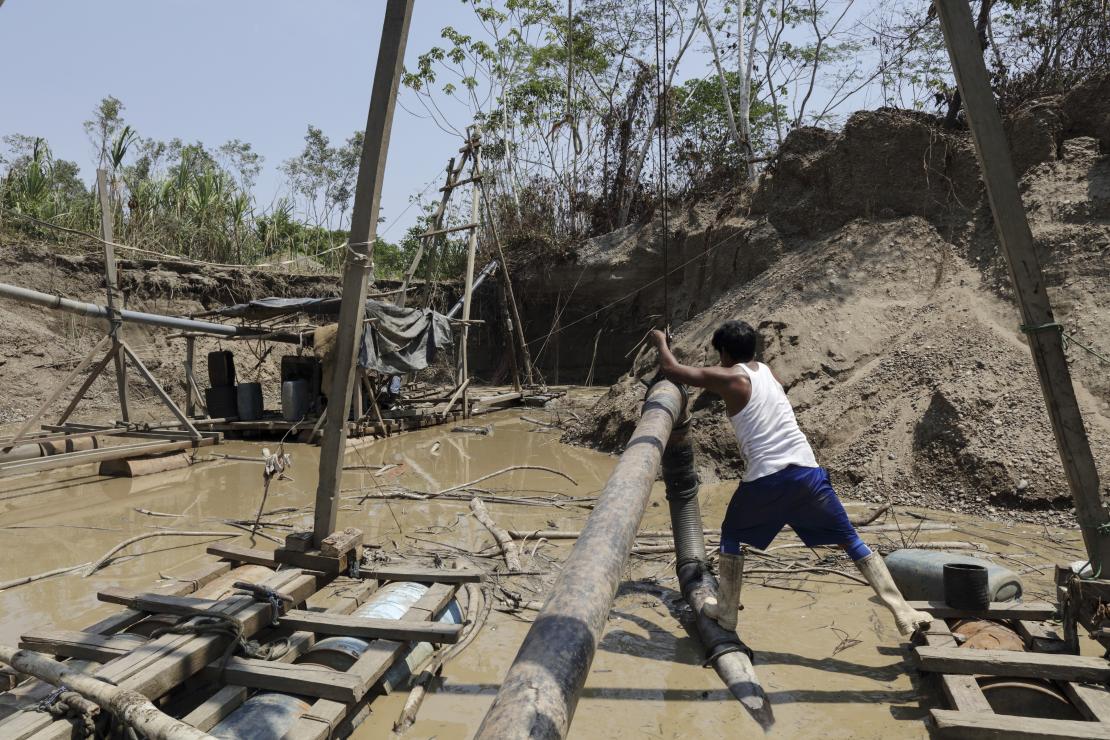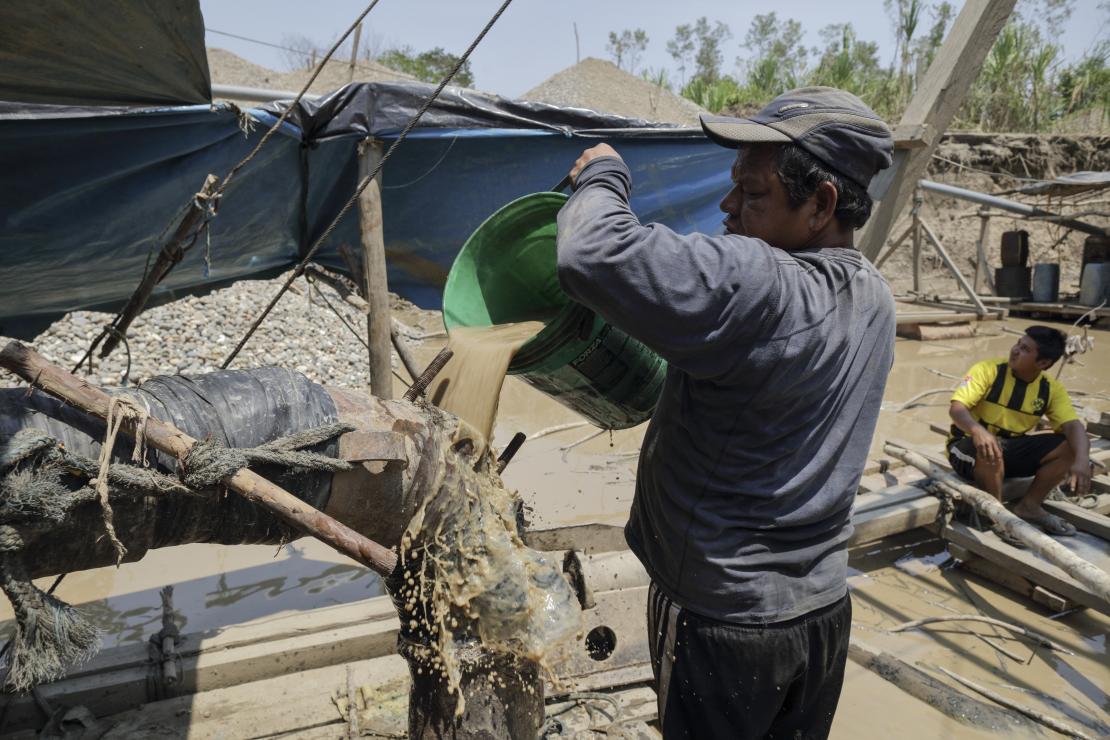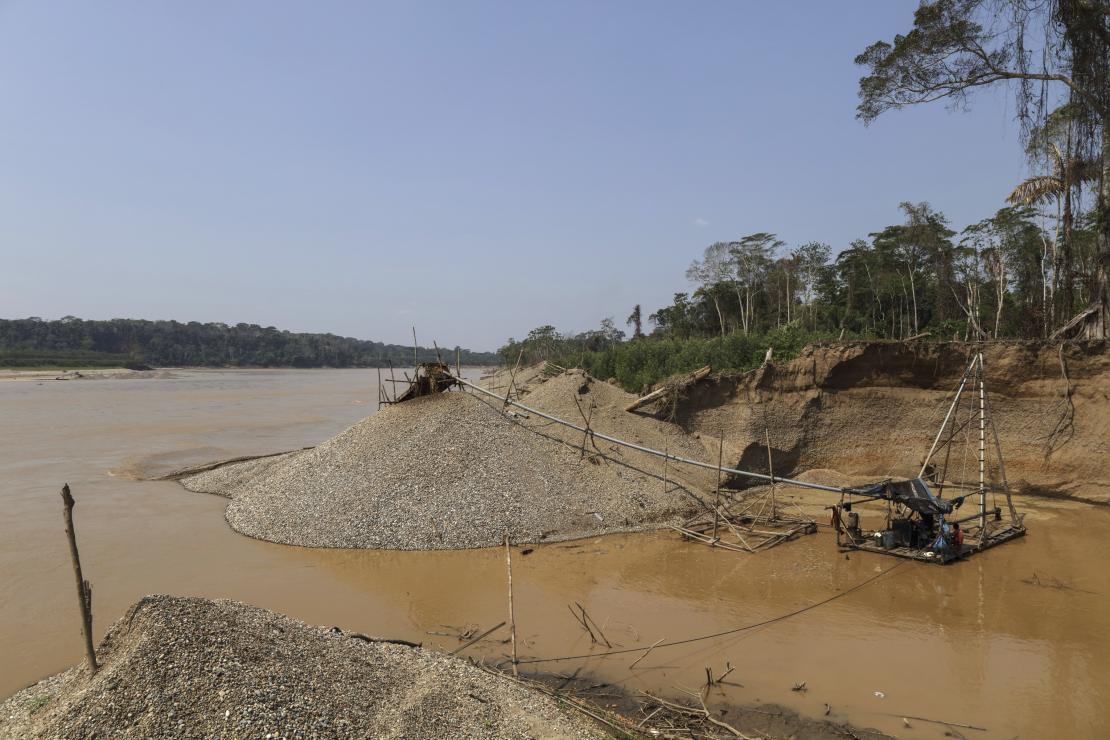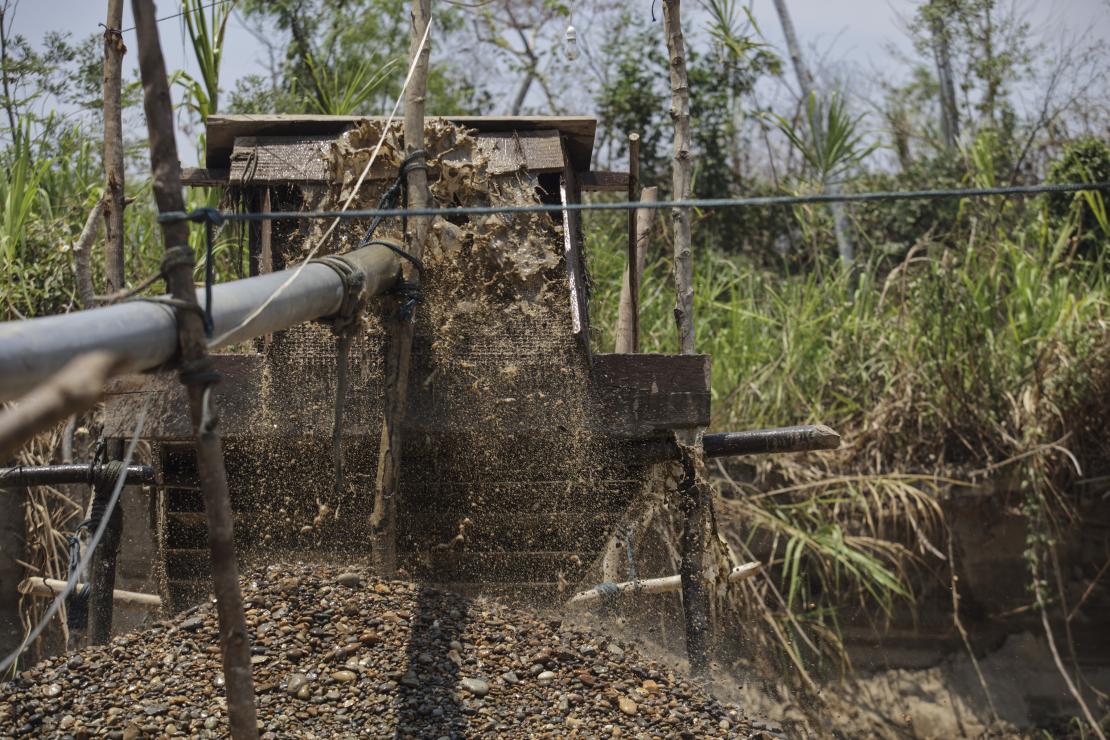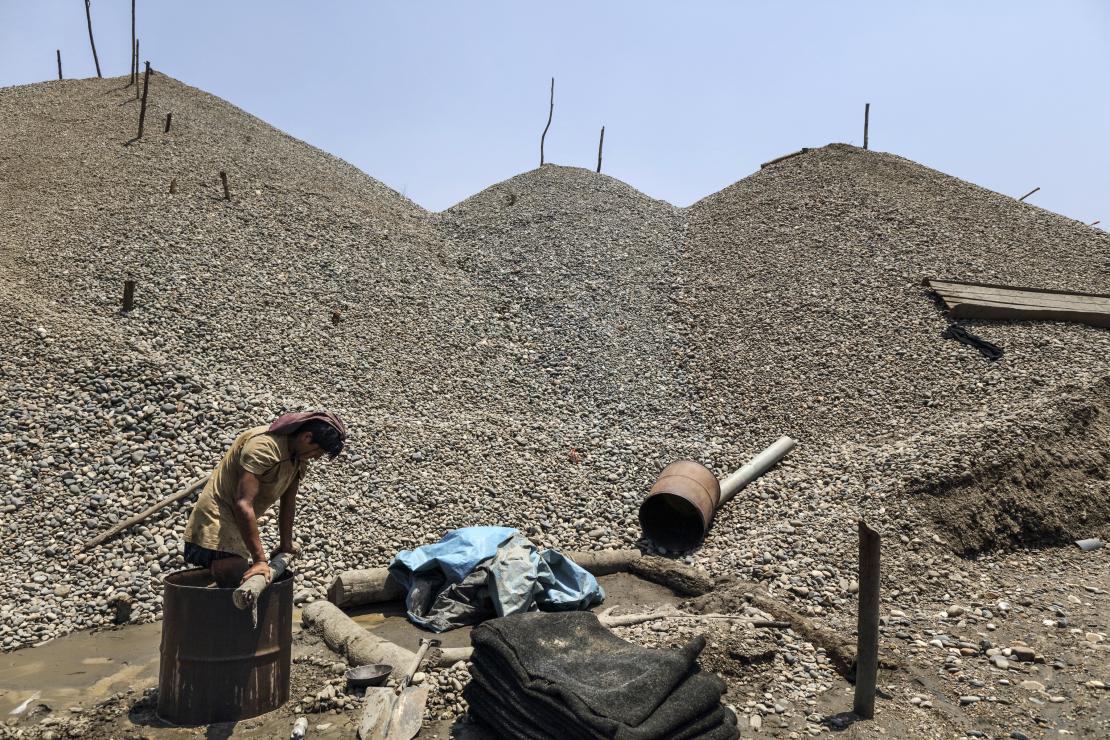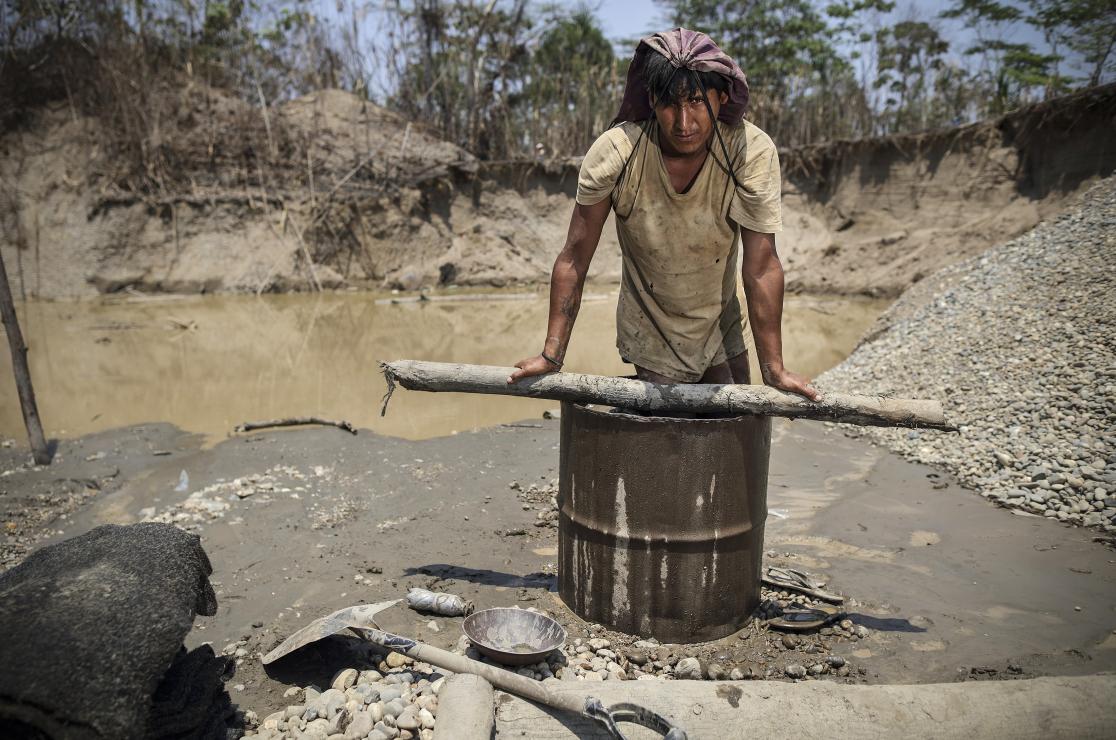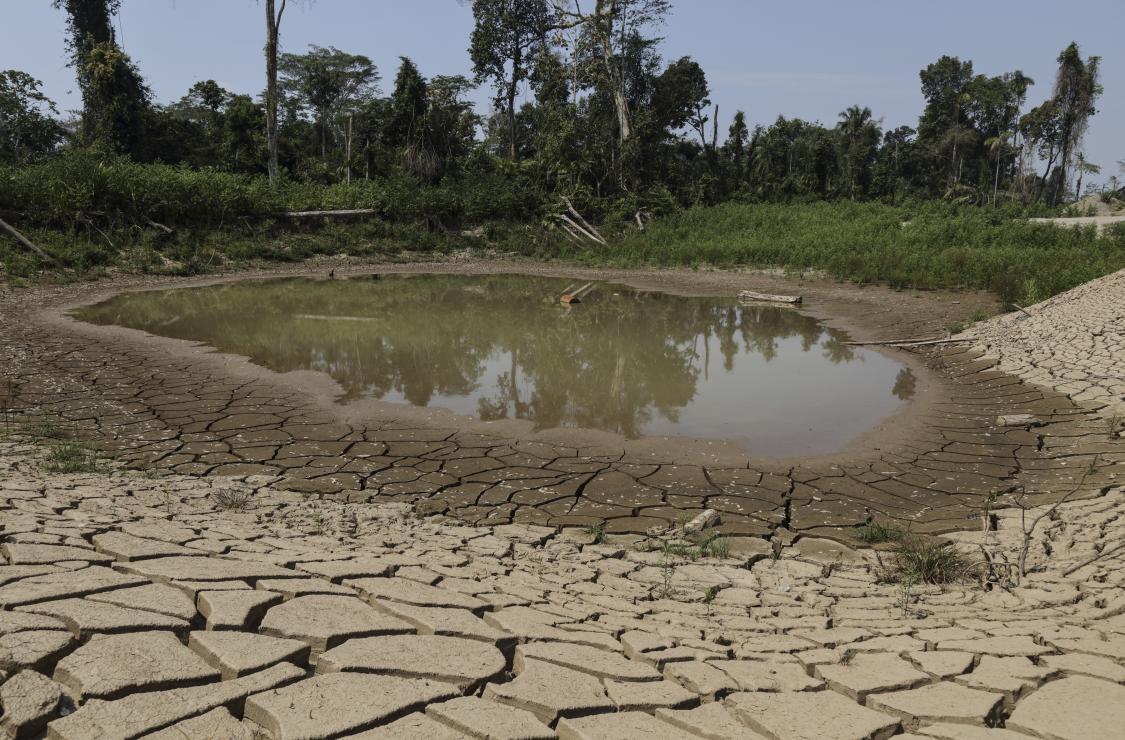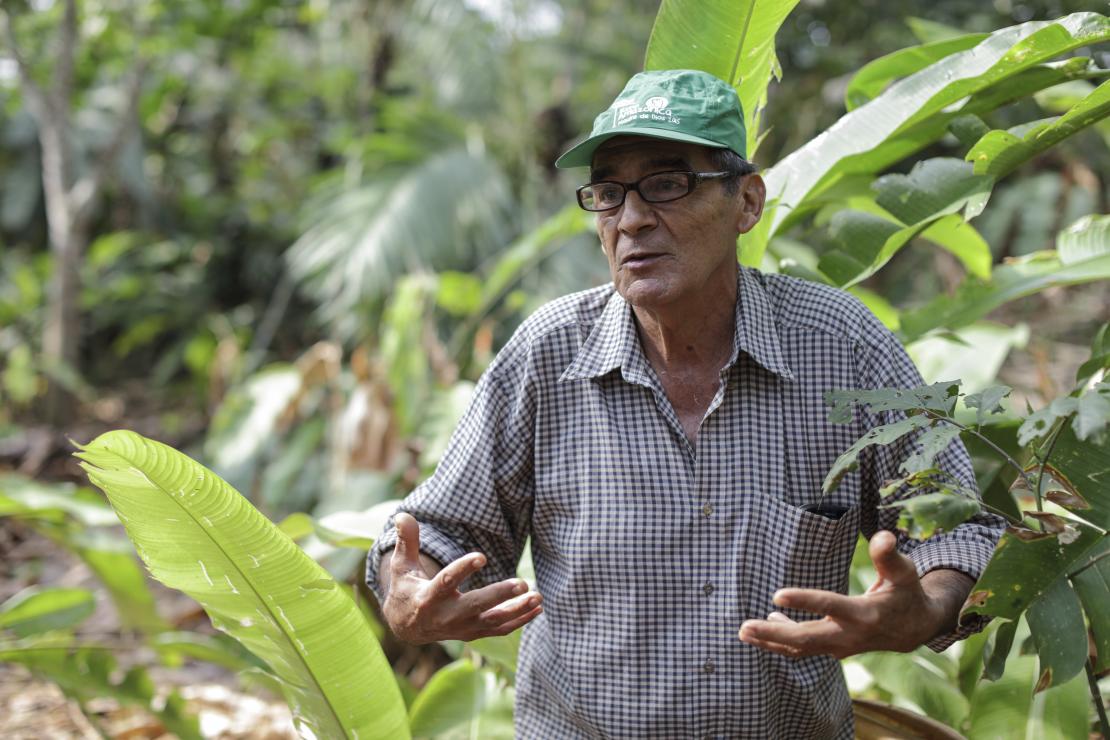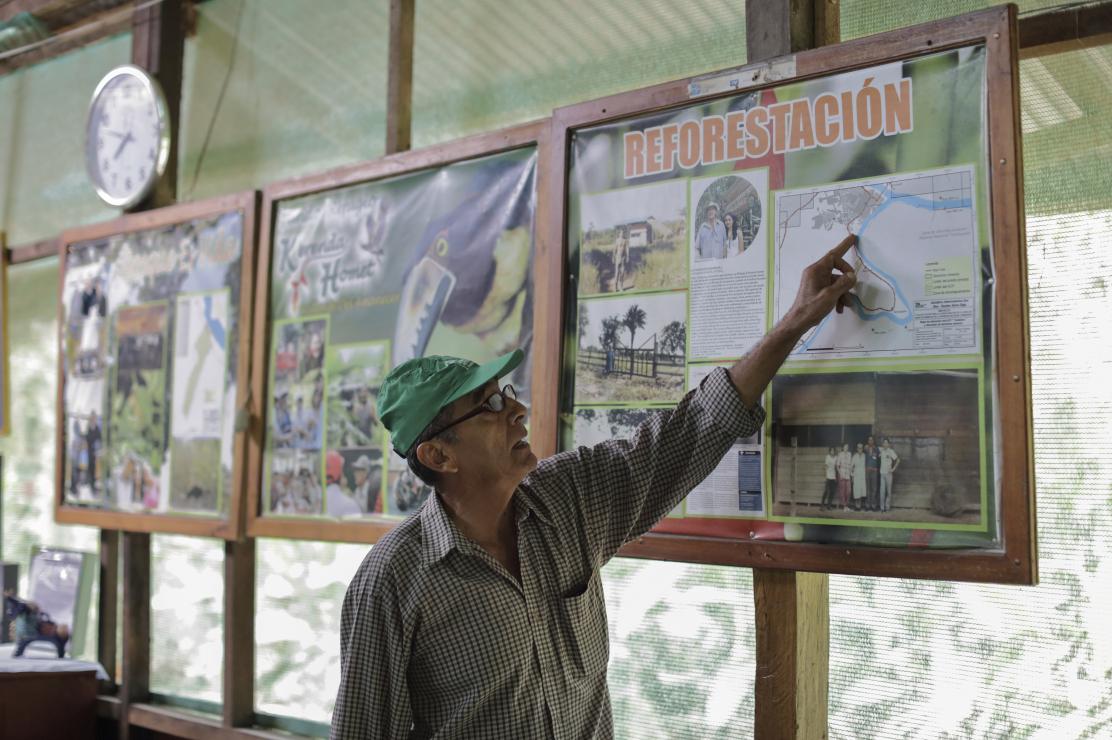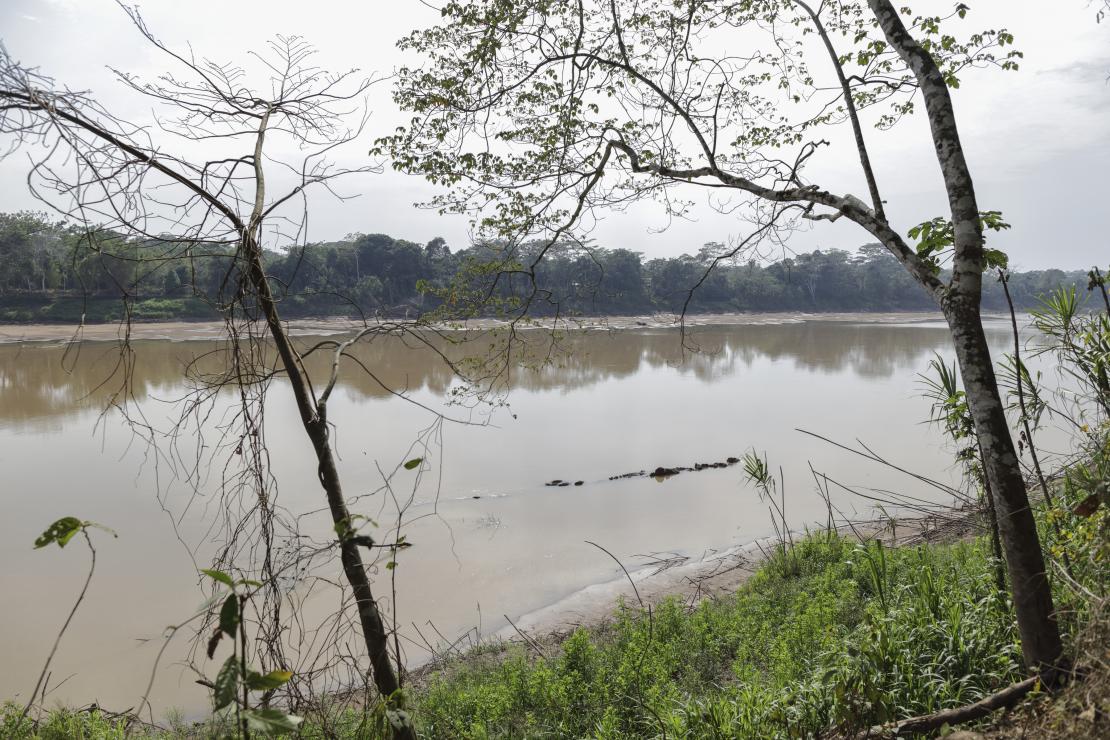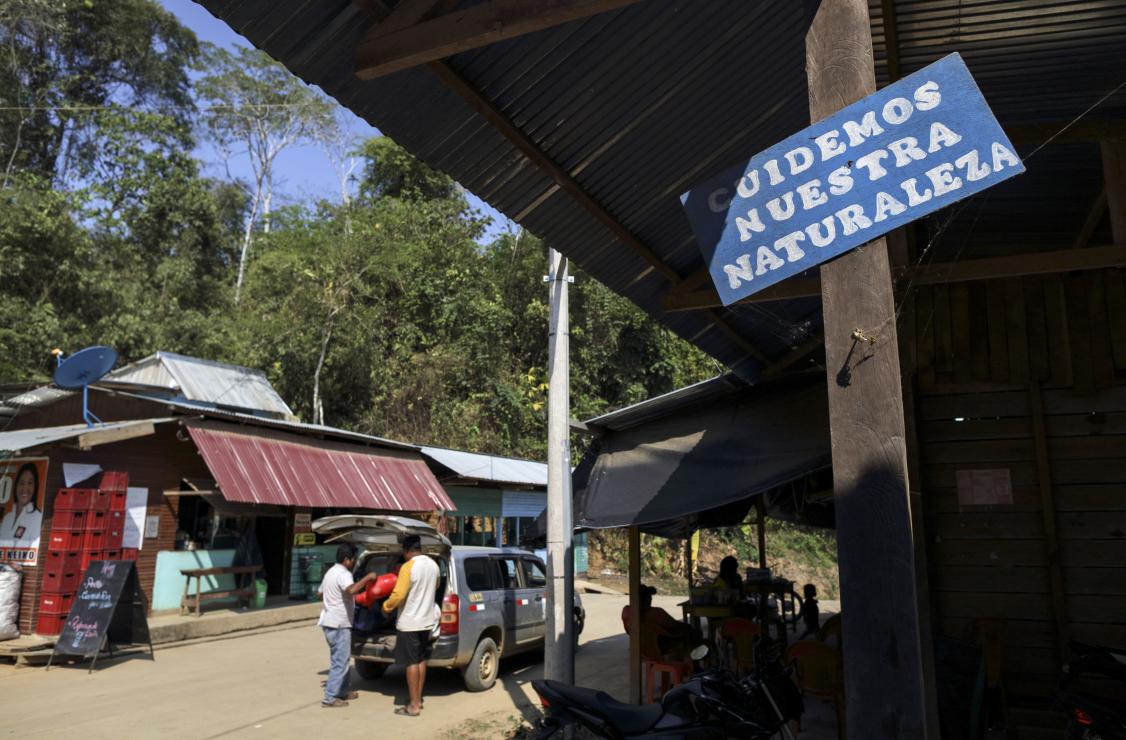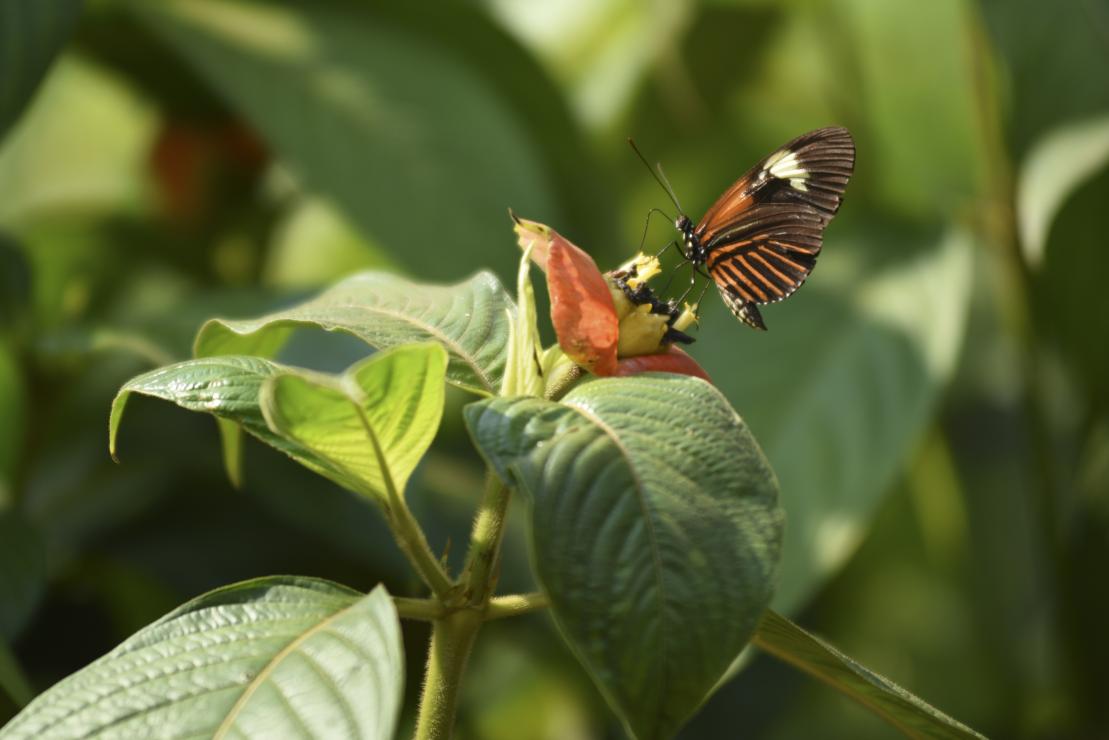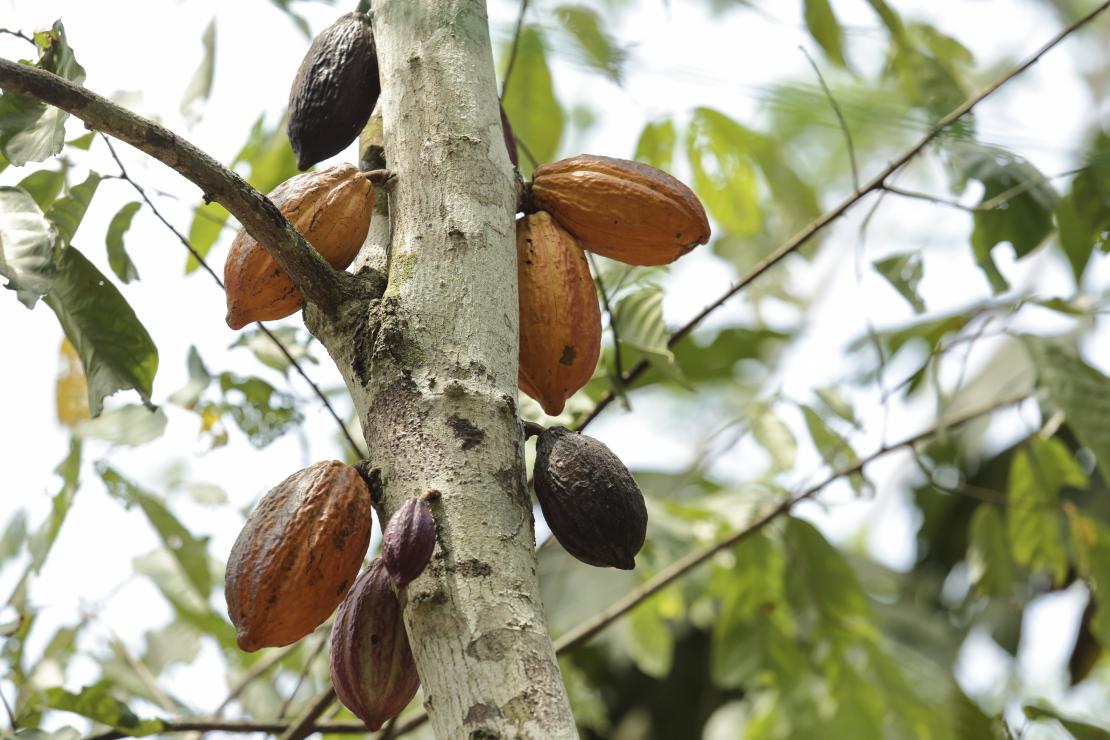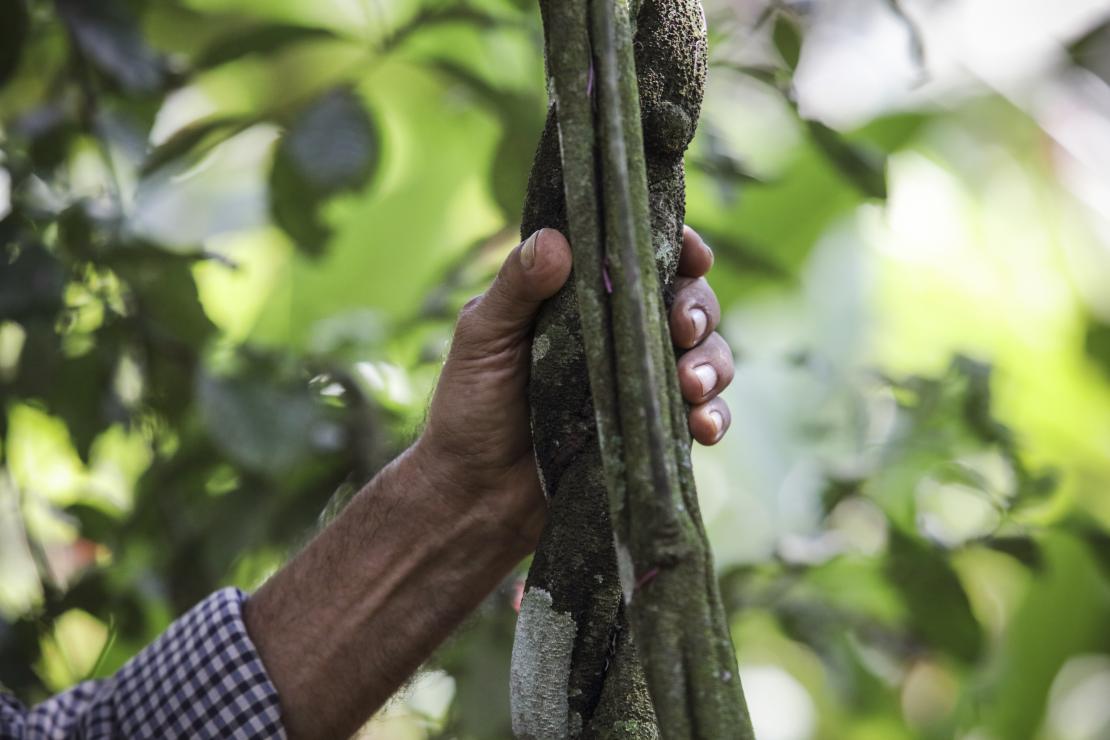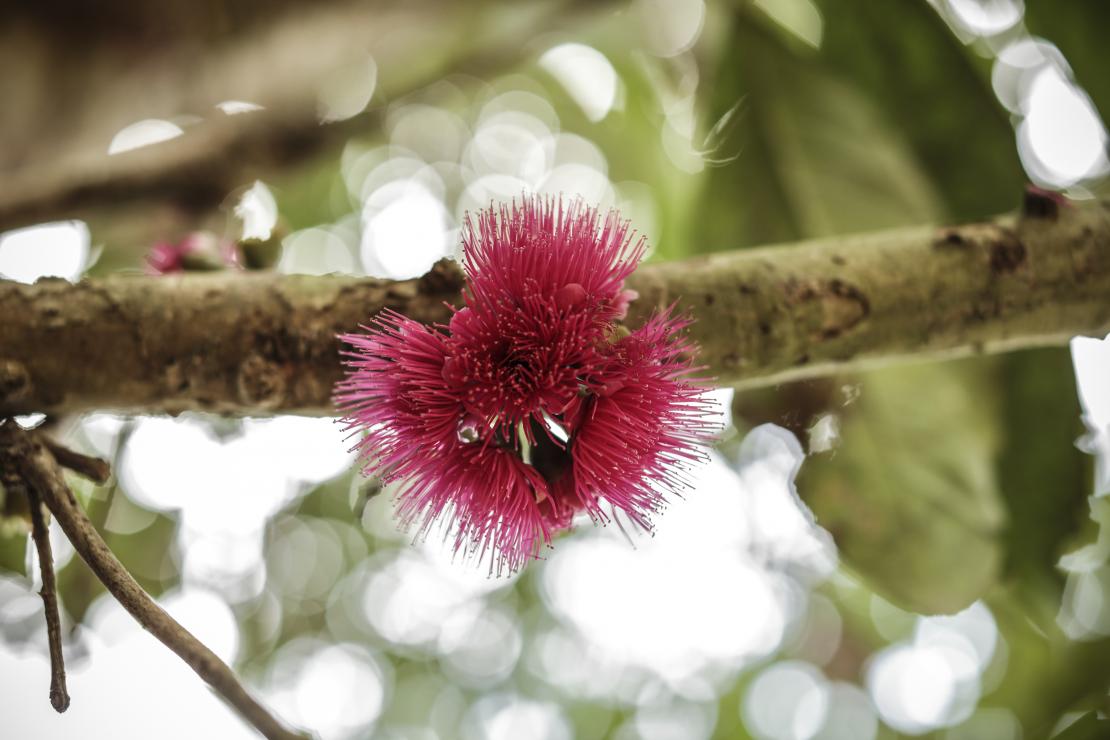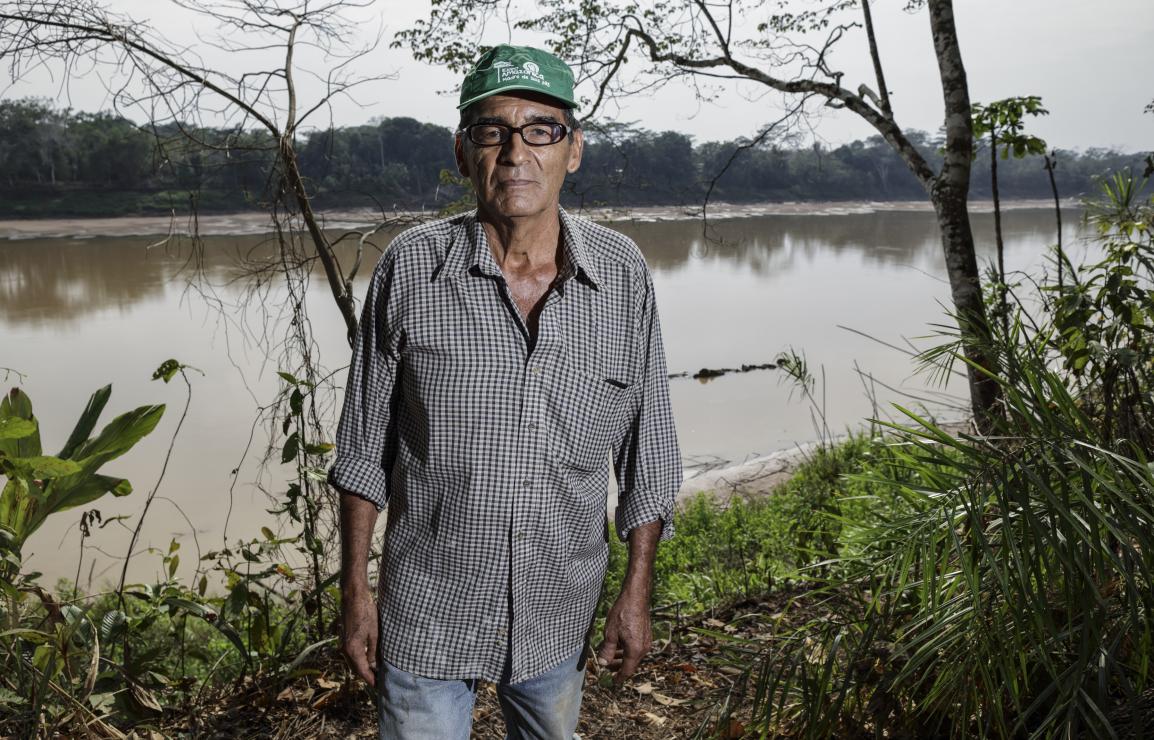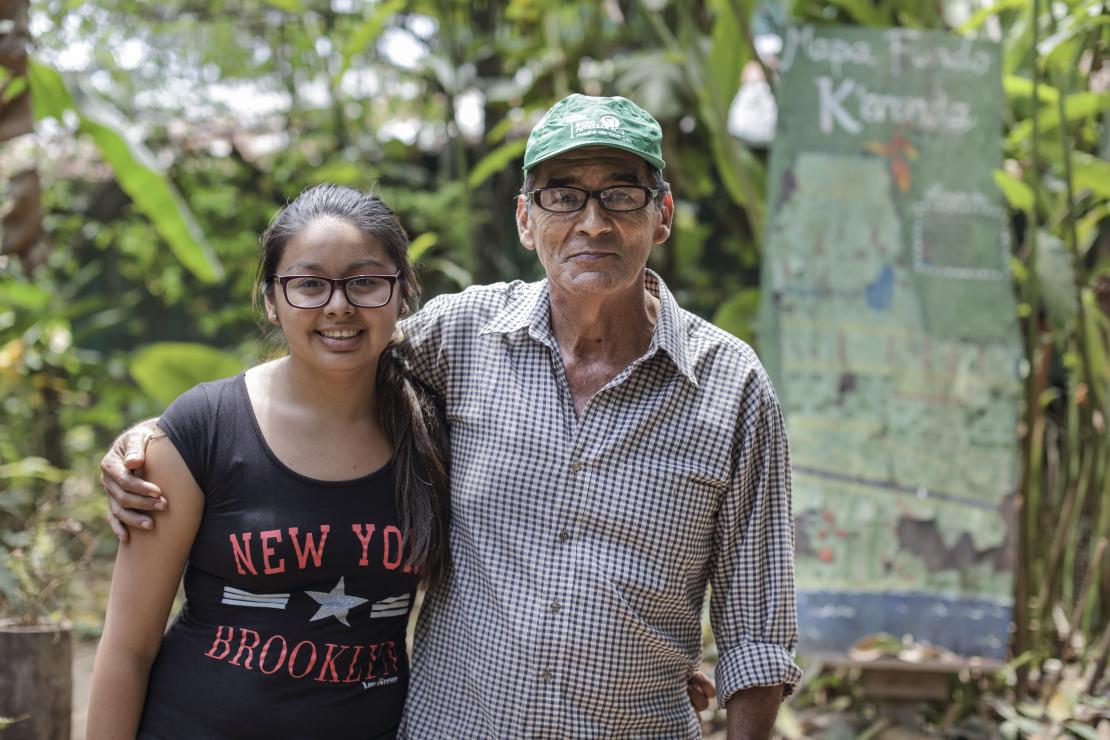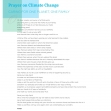

The Pull of Peru’s Gold Rush
This story is part of a year-long campaign called Living on the Edge of Climate Change, which shows how the changing environment is affecting the world's most vulnerable.
I do not know much about gods; but I think that the river
Is a strong brown god - sullen, untamed and intractable,
Patient to some degree, at first recognised as a frontier;
Useful, untrustworthy, as a conveyor of commerce;
Then only a problem confronting the builder of bridges.
The problem once solved, the brown god is almost forgotten
By the dwellers in cities - ever, however, implacable.
Keeping his seasons, and rages, destroyer, reminder
Of what men choose to forget.
- From Four Quartets by T.S. Eliot
Sitting in a long boat on the Madre de Dios River in southeastern Peru, it’s impossible to not notice the beautiful surroundings. The sun shines on the tranquil, brown water below. There are birds chatting and watching the visitors very closely. It’s quiet except for the dull motor of the boat. It’s easy for the eye to be pulled to the dense, green jungles of the Peruvian Amazon and for the mind to wander.
But after about 15 minutes, the meandering river opens up to the other scenery of this region: makeshift wooden rigs on the shores of the river. People look like ants as they climb the rigs which are digging deep for the prize. You’ve stumbled across Peru’s gold rush, and it’s these “uglier” details most of us choose to forget when we look down at our wedding ring or at a favorite pair of earrings.
Years of illegal gold mining have taken their toll on this part of the Amazon rainforest. Deforestation and pollution have led to climate change, health concerns and, in some cases, economic ruin. People have left their homes and families, pulled to this part of the world by the promise of a golden opportunity. That opportunity, in the end, may be vastly different from what they imagined.
But who is to blame here? And what can be done to stop the negative impact on our environment and these communities? The questions—and answers—are more challenging than you may think. But they are questions all of us—even those who will never see the shores of the Madre de Dios River—have a responsibility to answer as members of the human race.
THE MINERS
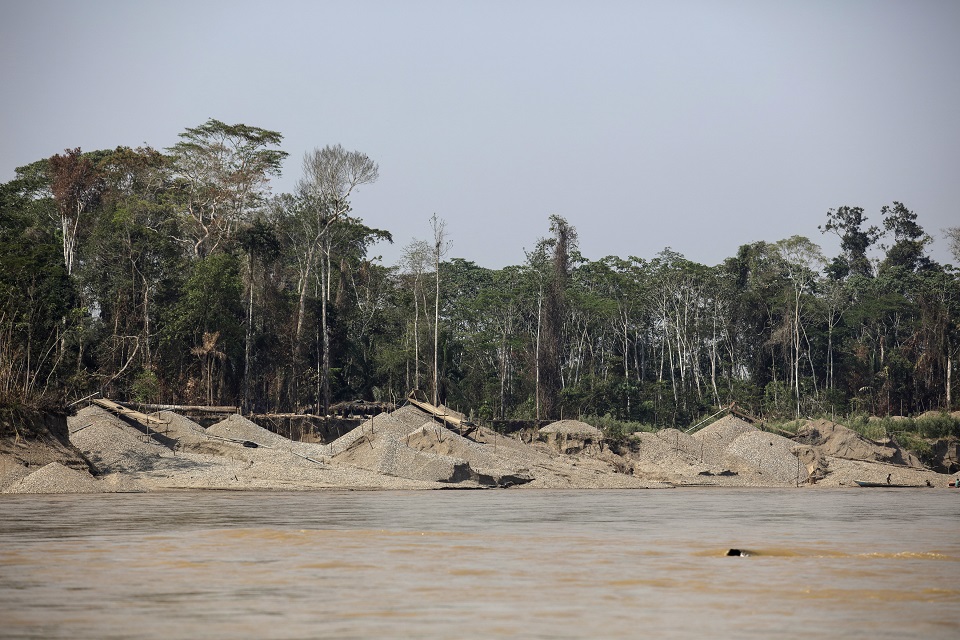
They call it the beach. Instead of umbrellas, this beach is dotted with mounds of sand, mud, gravel and rocks. These are the “leftovers of the gold mining process.” Behind these mounds are thin lines of trees. And behind them is even more mining equipment.
“If you navigate the Madre de Dios River, you will find the miners at the edge of the river with small machines taking soil and water from the bottom of the river to find gold. If you go into the Amazon territory like a kilometer, they will be able to find whole hills of material that has been removed from the ground,” says Tattiana Cotrina, project manager for Catholic Relief Services. “This work generates a change in the ecosystem because it totally destroys vegetation, visually changes the Amazon territory.”
Madre de Dios is in something of a “gold rush” right now.
“In the last 10 years, 15 years, with migration pushing out of the highlands from the north of Peru, the lower cost of mining here in Madre de Dios, has had this major pull effect,” says Joseph Kelly, CRS head of programs in South America. “In the last decade, we’ve just seen a massive expansion of all sorts of illegal mining practices.”
“What’s going on right now in Madre de Dios is nothing short of a gold rush, just like San Francisco in the 1840s. It’s driven by the high gold price worldwide. The type of mining in Madre de Dios, though, is a particularly destructive type of mining. The only way to get at the gold is to cut down the rainforest and sift through the river sands,” says Lawrence Rubey, Mission Director USAID/Peru.
“It’s kind of an apocalyptic Mad Max landscape, where the earth has just been turned upside down on its head and you have a landscape of mud, earth, rocks. It’s barren of vegetation and people are just covered head to toe in the mud and sludge they’ve been working in to extract the gold that they’re looking for. It’s surreal.” – Joseph Kelly
But for miners it’s a reality, and it’s also their livelihood.
Miguel Herrera has been a miner in Madre de Dios since 1981. As manager of the Rebeldes Limited Liability Mining Society, he’s proud of his work and eager to show why his mine is different.
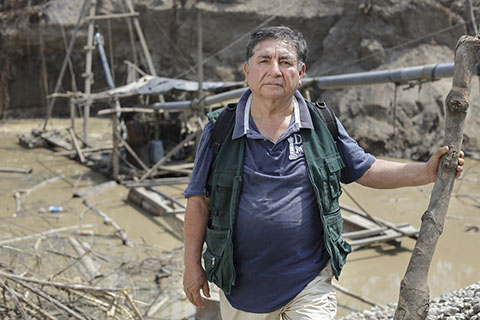
In Peru, mining is not a clear-cut business and the issue of territory or land is a constant struggle. Some miners, like Miguel, have been granted a concession by the government to operate on a piece of land. Miners with concessions pay fees to be able to work, but many of them still have not completed the long and very difficult government formalization process. Then, there are the illegal mines that pop up anywhere, especially in the protected areas and reserves. These are the mines that Miguel says are giving gold mining a bad name in Peru.
“I came here to do mining from Arequipa [Peru]…with the mining bank that had the concession. I stayed. In Puerto Maldonado (the city) at that time, there were about 7,000 to 10,000 inhabitants, and there were no technicians. I met miners who were already here, and I stayed to help them prepare the reports,” Miguel says. “But some people are coming that have no knowledge of mining.”
Forty or fifty years ago, Madre de Dios was not a heavily populated region. But now the bulk of the current population in Madre de Dios is a migrant population.
“Madre de Dios is experiencing between 4-5 percent population growth every year, which is attributed to the mining basically. A lot of them come in unprepared. A lot of them don’t have mining experience. They often seek the path of least resistance, the most economic, cheapest way to go about it. They often work with different outfits that hire day laborers in these mining camps and these are the ones that are unregulated, really in the wilds of the jungle and the ones that are environmentally creating the most damage,” says Joseph.
“These migrants are being drawn to Madre de Dios to work as illegal miners by the high salaries. Salaries are 100 soles per day, which is about $30 and double what they would get for unskilled or semi-skilled labor in a large urban area like Lima,” says Lawrence.
“The people who need work become illegal and are entering where there is no concession. This greatly discredits us.” – Miguel Herrera
Gold mining is hard work. First, a tube is lowered into the ground to where the material is located. It is suctioned out through a pump, and the material is strained through a pipe. The remaining material then is funneled up into a “gutter” lined with carpet. The material is flushed and the heavier materials remain behind. Many miners then use mercury to pull the gold out.
This process does take a toll on the environment. There is deforestation, but another concern is the mercury used to extract the gold.
“After the sand is sifted in the carpet, a material remains that is gold combined with grit and other minerals. This material is placed in a cylinder and that is where the mercury interacts. The mercury causes the gold to clump. They drain the mercury and the gold is subjected to heat to finish the melting process,” Tattiana says. “At the end of the process, the mercury that is left over can be reused, but a percentage is thrown into the river or onto the land. It then arrives in all of the communities, including Madre de Dios, because the water they drink is from the Madre de Dios River. The water with which people bathe, with which people make their food, is water from the Madre de Dios River where mercury has fallen.”
Miners are working up to 15 hours a day in the heat, and the rig is continuously staffed 24 hours a day. At the end of the day, Miguel says about 12-15 grams of gold is extracted. It’s basically this:
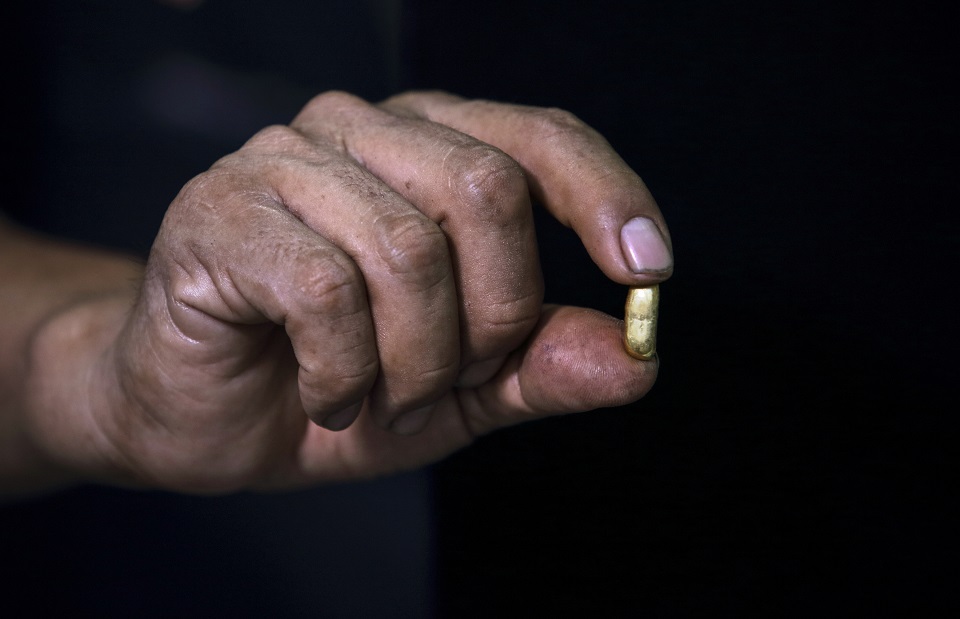
Twelve to 15 grams is the equivalent of no more than three rings.
“You do not become rich here. The one who becomes rich is the merchant who sells all of the inputs [the machines],” Miguel says.
Ciriaco Pilco Mamani is also a miner. He’s 70 years old and came to Madre de Dios from Cuzco 40 years ago. He never left.
“I came for the money. In Cuzco, you couldn’t earn the same as here. My children were born here. We opened a school. So now I cannot go back. I had to live here, make my little farm, and make my home. Here, everything is work,” he says.
Mining is also work that has taken a human toll.
“When you come and see for the first time what mining is doing to Madre de Dios, surely you feel that mining is finishing off an ecosystem that has taken billions of years to form,” Tattiana says. “But in our work, we work with people. And when I go to these areas, I see those people, and I feel it is the only alternative that they have. I also believe that it should be worthy for them based on the way they work.”
“They are enduring the marginalization of the population and the marginalization of the entire world because they are destroying the rainforest – the lungs of humanity. But they are people who are not given another alternative.” – Tattiana Cotrina
Ciriaco says the illegal mines are hurting everyone. The environmental damage through illegal mining is far more destructive than other kinds of mining, as illegal miners move very quickly over large amounts of land.
It’s like a game of environmental Pac-Man. Large swaths of land are consumed with nothing left behind. That is what is happening in Madre de Dios and other places. Illegal mining is deforesting the Peruvian Amazon. Even in one of the most biodiverse places on earth, what is left behind may not be able to recover. It’s game over.
Both Ciriaco and Miguel say they are using technology and techniques to protect and reforest the land, but want more support from the government.
“We have been here 40 years. [Some of the illegal miners] are here not even 10, but they have made a desert. Why do they do this? Because nobody makes them respect it,” says Ciriaco. “You have to leave everything just the same. We want to leave it the same. This is our concern.”
“I think the [government] standards have been more to prevent work in mining in Madre de Dios, than to improve the work of the miner. So what we have to do is change the rules. We have to analyze the two processes. One is technology and the other is the rules that are suited to the reality we have in order to work in peace,” says Miguel. “We who work formally want to improve technologies, we want some good training to take place in order to learn. We also want to leave something behind. When the gold runs out, what are they going to do?”
THE INDIGENOUS
The struggle over land—and what is and what isn’t allowed on it—deeply touches this area’s 36 indigenous communities. About 10,000 people in seven different indigenous groups make up the Native Federation of Madre de Dios. These groups pride themselves on taking care of the forests in the region. They now feel threatened by migration and mining. The land they have lived on for a long time is in question.

“We, as indigenous, have lived without a territory. We have seen that in Madre de Dios there was going to be a great migration. If we do not ensure land rights, then they would invade us,” says Julio Cusurichi Palacios, president of the Native Foundation of Madre de Dios or FENAMAD. “The government does not give us a title because they want these spaces so that they can continue working. And when we have the title, for them it’s a disturbance for development. But for us to be titled, to recognize a territory, is to ensure the survival of the future of our children.”
Some members of the indigenous communities say mining has divided their communities and changed their lives for the worst.
Angel Raul Jipa Vargas is from the native community of San Jacinto. It’s a community that was founded in the 1980s with about 60 or 70 families. The number of families has now dwindled to 10. People are leaving for work in the city, but those who have stayed struggle with the role mining plays in their lives.
“Mining worked for a long time in the community, and my parents worked in mining. But they worked in a traditional way with their wheelbarrow. But as time has gone on, big motors that are called suckers have been brought in. And now people from all over come here. They have entered into the community without permission,” Angel says.
“A lot of these indigenous groups are on the front line. They see the impact. It strikes more close to home because it is home for them in these reserves,” Joseph says. “By national law, they are protected, but the practice that is going on runs a little roughshod over those policies that have been put in place.”
The government is allowed to grant mining concessions in a native community. That has made life more complicated for people like Angel and Julio.
“We’re really going through a very unfortunate crisis in the community. Mining has caused us enough problems: disunity, gossip, selfishness. Everyone wants to get more,” says Angel. “But we want to move our community forward. Not let it die, but move it forward. For me, mining can go no farther in the community.”
Julio says the mining has caused problems not only for those living in these communities, but for the whole world.
“There is a feeling that after we have given our life to a whole ecosystem, in a couple of years it is destroyed. This is the way global warming continues to increase,” he says. “Everyone should be concerned, not just us."
THE FARMER

Nasbat Marleni is a nature-lover. She has worked with cacao—which is used to make chocolate—since 2013. She and some colleagues have worked for years in agroforestry, and have learned to market their products and adapt to changes. But Nasbat has had other challenges.
She and her colleagues formalized their organization in 2000. They found available land in Santa Rosa, Peru. Even though she worked the land for years, in 2004 a mining concession was given for that land.
“We said, ‘We have chosen this as a farm.’ The miner says, ‘No, I want to work because I have legal documents. I have a title to work mining. I have to extract gold.’ And the man came with his machinery,” she says. “The situation was terrible.”
Nasbat says the effect on the environment is profound.
“We have long told them, ‘If we continue like this, there will be more. It will be worse,’” Nasbat says. “We farmers keep the earth alive. But instead when you take out the gold, you do not plant anything, you’re not returning anything to nature, and the changes are therefore tremendous. And we live the consequences.”
Nasbat also feels a lot of personal pain. She says the miners have told the government not to title the farmers’ land. It’s hard for her to even interact with the miners.
“Mining has turned us into firewood. There have been people who have defended the land; there have been people who have defended gold. So which weighs more? In our population, there is divisiveness.” – Nasbat Marleni
It’s that divisiveness that CRS and partner Caritas Madre de Dios are trying to heal. Through a USAID-funded project, the goal is to create a dialogue among miners, indigenous communities and farmers over the use of land, and to construct a “Plan de Vida” or “Life Plan” for the groups. The project also seeks to make an impact on the government to improve policies, including those for the formalization of mining or agriculture, in Madre de Dios.
“You cannot dialogue, you cannot reach an agreement, you cannot negotiate if the three protagonists–miners, indigenous communities and farmers–are in unequal power, in unequal opportunities, in technical inequality,” says Tattiana. “Mining in Madre de Dios has economic power. It also has the power at a technical level. They know the laws that are favorable to them. The farmer in Madre de Dios does not have the resources a miner has. He has spent 15 years trying to be titled and the government does not grant him title.”
The ultimate goal of the project is to have a balance of power and keep the dialogue coming.
For Nasbat, it’s still an uphill battle.
“They have not lived what we have lived. For example, the native lives in harmony with the miner because he says that they have always worked with gold so they understand each other. Sometimes it’s enough that they say the word ‘mining’ and it gets to me. Sometimes I can’t deal with what has happened to us before, and my emotions are suddenly greater that sometimes I can’t even get along with them,” Nasbat says.
THE SCIENTIST
Bringing science to the people of Madre de Dios—and to the world—is something near and dear to Cesar Ascorra’s heart. As a biologist and national director of the Center for Amazonian Scientific Innovation, he wants people to know that Madre de Dios is one of the most diverse sites not only in Peru, but also in the world. But this area is also in trouble.
“Despite having good forests and good percentages covered in protected areas, this is very threatened. The area is threatened by external pressures, as well as the pressure of extracting gold and illegal mining. There’s also the impact of climate change,” Cesar says.
“Peru is definitely witnessing, experiencing the symptoms that we’ve come to know and associate with climate change, with erratic weather patterns, and abnormally high or low temperatures in different parts of the country,” Joseph says.
Cesar says migration to the Peruvian Amazon for wood, gold, rubber or other resources has taken a toll on the environment.
“The migrant sees the Amazon as an endless reserve of resources that he can take from there. Everything is there so it must be taken out,” Cesar says.
And migrants bring their own cultural practices with them. These practices often clash with those of indigenous groups and bring more discord.
“In the Andean region, for example, they burn. They burn for agricultural purposes. They burn the pastures. The Amazonia indigenous generally does not burn,” says Cesar. “The indigenous use the beaches [riverbanks]. The beaches are where they can cultivate fast-growing crops like corn, beans, watermelon and others. There is no need to burn. When the Andean migration came, they brought the practice of burning that is apparently easier and faster.”
The burning leaves behind bare soil that can make it hard for anything to grow. Because the soil has been stripped of nutrients and there’s no vegetation to protect the soil, levels of arsenic and mercury are left behind. Add in the mercury from mining, and the environmental damage is devastating.
All of this affects those living and working in the area.
“All environmental problems are closely linked to poverty. They affect the poor who are the most vulnerable.” – Cesar Ascorra
“The poor suffer the effects of any unplanned human intervention. The issue of climate change affects them. The issue of pollution affects them. In turn, the poor with few resources, live by subsistence that also generates more vulnerable conditions,” Cesar says. “So, a farmer destroyed the forest. That does him damage, but also continues destroying the forest. So he is a victim and at the same time victimizes himself for the kind of practice he does. A miner has high levels of mercury in his body, but they generate chronic poisoning in other non-miners that eat the contaminated fish.”
THE ADVOCATES
The Catholic Church takes a strong stand of caring for our natural environment and for life itself.
“The Church takes a position on what is happening in the world today with climate change, and the crisis caused by man through this system that favors money over dignity, life and the natural environment,” says Monsignor Pedro Barreto Jimeno, Archbishop of Huancayo in the Andean region of Peru. “Instead of generating a more fair distribution of natural resources and wealth, it is creating two groups that are very, very far away from each other. One very small group holds the wealth and another group experiences poverty.”
“The Pope has said that the Amazon is one of the lungs of the world. It is important to note that this is the issue that affects everyone, without distinction of religious, political or economic creeds. We are all in the same family – the human family. We have to work together.” – Monsignor Pedro Barreto Jimeno
Monsignor Barreto says environmental degradation and climate change is having an impact on global migration. He says people often leave their homes not only in search of economic opportunities, but also because the natural environmental has been affected. Many have come to Madre de Dios to mine because their soil for farming has been destroyed. Others have left their homes because of an unpredictability in the climate.
“There are environmental refugees on every continent. This is something massive,” Monsignor Barreto says. “They are uprooted from their natural environment, they are uprooted from their cultures. We cannot at this time say how serious it is to move into a discard situation, of disposable people, of people who do not have a greater significance.”
The Church in South America is working to protect the Amazon through the Ecclesial Network for the Pan-Amazon or REPAM. Seven different countries with significant portions of their territory in the Amazon work toward coming up with a unified platform to the Church to protect the environment.
“I believe Pope Francis’ message in Laudato Si’ [the encyclical about caring for our common home], is very clear. It’s calling all of us to be stewards, in being custodians of our environment,” says Joseph. “I think those words resonate particularly strongly with church organizations and those based in the Amazon. We’ve worked for decades with indigenous groups, with social ministries and on environmental issues around mining.”
“It is said that 20 percent of the Amazon territory, 7,800,000 hectares, is already pillaged. The Amazon is essential to protect life. You have to do a big job so that illegal mining is nipped in the bud,” says Monsignor Barreto. “When one sees the large machinery in the middle of the destroyed jungle, the most humble people don’t do that. Who puts these machines there? The Peruvian government, in addition to the companies, have profited from the health and life of the population.”
There’s also the social effects of mining.
“We see that everything is connected. If we talk about climate change, it is the irresponsibility of people. It’s the corruption. It’s the migration. It’s human trafficking.” – Monsignor Barreto
Illegal mining requires equipment, but it most of all requires people. In Peru, gold mining is closely tied to human trafficking, specifically child labor, forced labor and sex trafficking. Madre de Dios is one of Peru’s largest gold producers. But it also has one of the highest concentrations of illegal mining.
Madre de Dios, bordering Brazil and Bolivia, is in the heart of the Amazon. A major part of the territory can only be accessed by its extensive waterways. These waterways, which can be under-policed, also aid in the transport and trafficking of men, women and children.
The trafficking continues here because many mining camps also lack a police presence. Authorities either lack the resources to go deep within the dense Amazon jungle or are sometimes afraid of instability. Land use is simply not well regulated.
Many migrants travel to Madre de Dios on their own free will. But for those who lack a national identity document, the illegal mining sector may be their only chance for employment. Workers are quite often recruited in their communities. They may be told stories of others striking it rich, but are provided with very few details about their conditions of employment. Some workers may be given money or clothing as “gifts.” Those “gifts” turn out to be debts that need to be repaid. Other workers are sometimes sold by their family members, who received money for recruiting them.
When they get to the camps, workers often are isolated and closely watched. They do not receive a salary because they are paying off their “debt,” and therefore don’t have transportation to leave.
“They arrive. They’re put in these horrible, deplorable conditions. They are putting their health at risk. But they are then part of the equation that’s actually deteriorating or destroying the environment,” says Joseph.
Luis Alberto Sanchez Villaran is in charge of the Office of the Special Prosecutor for Human Trafficking Crimes in the department of Madre de Dios. He sees labor trafficking in the camps, but sex trafficking is also very prevalent. He says many of the victims are from Cusco and Puno, and are enticed by false job offers.

“Victims brought from those distant places are taken into those mining camps with no possibility of returning. The traffickers are very well organized. They are watching the victims at all times,” he says. “There are several employment agencies where they recruit victims–underage and adult female–through false job offers. The place where they will work is not the one promised. It is not a restaurant; it is a nightclub. It is not a city, but rather a mining camp.”
Luis says there are approximately 800 underage victims of trafficking in mining camps in Madre de Dios. Part of his job is to stop the trafficking from happening. One way is by patrolling the highways.
“We control all the buses coming into the department. We step in and get all the children off. We control the entry of minors who come without documents, who come without close relatives, who come without permission. Moreover, in the area of occupational and sexual exploitation, we developed many operatives in order to rescue those victims who are being violated in these sectors. We go with the firm hope of rescuing the largest number possible of victims,” Luis says.
This type of human trafficking crackdown in Peru is rather new. The prosecutor’s office of human trafficking has been running about a year. In that time, Luis says the prosecution has rescued and served 322 victims. He says about 30 people are serving time in preventive prison, as they wait for trial and a possible conviction.
While prosecution is bound to legal capacity, CRS and Church partners work to prevent human trafficking and to protect the victims. Campaigns explain triggers of trafficking to people and bring real-life testimony to communities. People who have escaped or survived trafficking rings are brought back to tell their stories. CRS supports work where policies on trafficking are developed.
“In terms of protection, the Church has been critical in providing safehouses and refuge for women and children who have been caught up in this schemes,” says Joseph.
“The mere fact of rescuing a victim is as equally important as rescuing all of them. Because it involves a person. So that motivates us to keep working. That motivates us to continue fighting this fight against human trafficking.” – Luis Alberto Sanchez Villaran
THE CONSERVATIONIST
While there are many groups, organizations and individuals fighting to protect the most vulnerable people in society, there are also those who are fighting for the natural environment. Some say pictures are worth a thousand words, and these pictures tell plenty.
Click on the images to experience the effects of illegal mining.
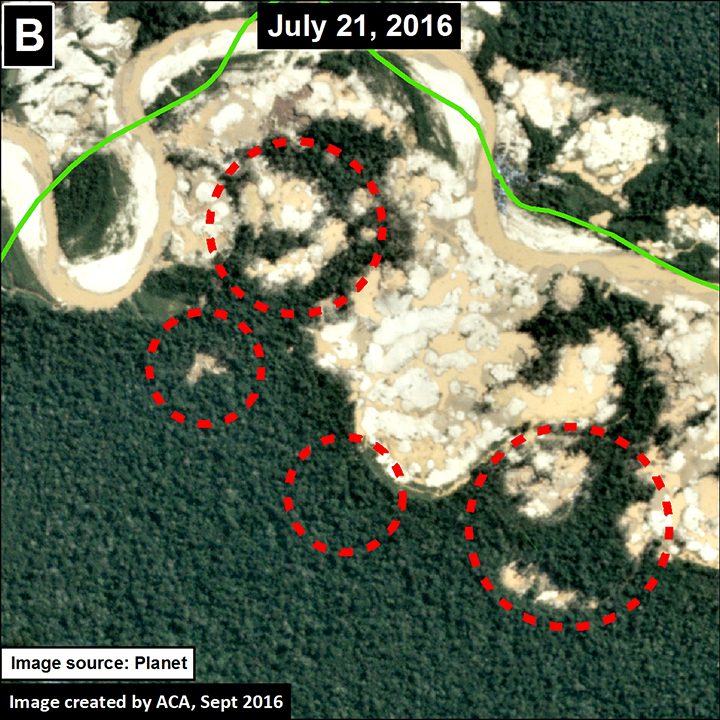


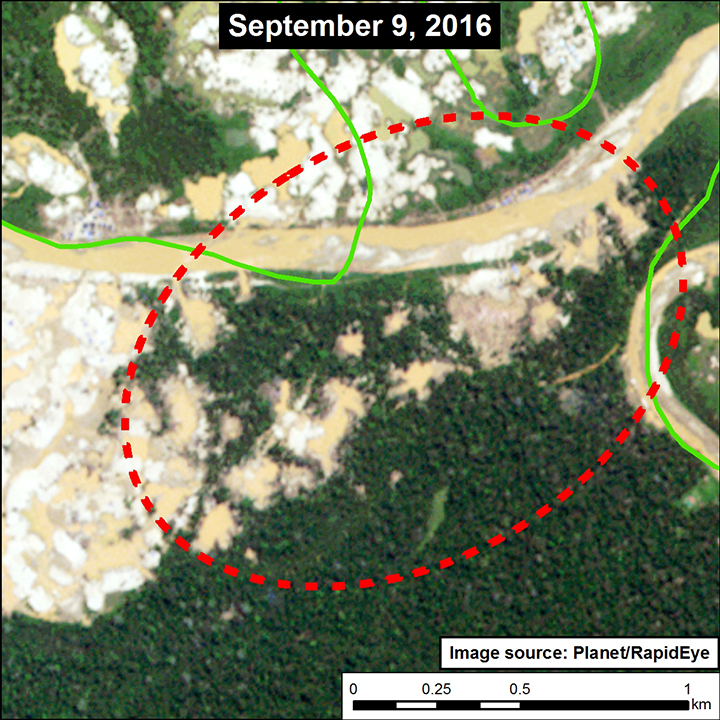
These images were created by the Amazon Conservation Association. The group has been tracking illegal mining in the Tambopata National Reserve in Madre de Dios since November 2015. In less than 10 months, estimates show that deforestation within the Tambopata National Reserve now exceeds 450 hectares, which is equivalent to 615 football fields.
The Tambopata National Reserve is a natural area protected by the government. It’s an area of great biodiversity. It’s also home to the jaguar and the giant river otter, which are emblematic species of Peru.
Out-of-control mining has led to deforestation and the elimination of many kinds of plants and animals. It’s a very dangerous activity for the natural area.
“The Amazon rainforest is one of Peru’s greatest national treasures. One way of thinking about the rainforest is that it is the lungs of the planet. But unfortunately, illegal mining, expanding agricultural frontier and other drivers of deforestation are affecting the ability of these lungs of the planet to do their job,” says Lawrence.
Conservationists say regulation only goes so far. Management and recovery of natural areas both need to be done consistently and well. There are many people leading recovery projects of areas degraded by mining.
One of those is Victor Zambrano.
Victor speaks like a poet. He loves nature and his passion for conservation is evident in his words.
“Change the world from a materialistic world to a world that represents the love of nature,” says Victor.
Victor, 69, says he was born on the “blessed land” of Madre de Dios. He left to attend school in Lima and have a military career, but then returned and set up along the Tambopata River. When he came back in 1987, he found his beloved land changed by illegal gold mining, a transcontinental highway, illegal timber harvesting and human migration.
For the last 30 years he has reforested land, planting more than 120 species of trees in about an 84-acre area. In 2013, Victor legally obtained the land and continues to protect it. The area is known as the K'erenda Homet Private Conservation Concession, in honor of his youngest daughter.
“I live every day, every hour of my life, as an element that lives surrounded fully by nature,” Victor says. “I am ecstatic to be surrounded by all of nature, by wildlife, by my forest that is full of the sounds of the trees, by the wind, by the birds. Since I returned to my land, I have lived here with conditions, with limitations, but I’ve never moved from here. And here I will leave my bones."
Victor says his way of living is not common, but he is happy to be called a rebel. He hopes there will be more people like him.
He has transferred his knowledge to his daughter, but he has also worked with other groups, including farmers, indigenous people and other organizations to address the concerns with illegal mining. He won an award from National Geographic in June 2016 for his conservation efforts in Madre de Dios.
“Because these things that are given to them here relate to environmental education, that not only stays in their brains, but they share with their parents and relatives. A combined average of 35-40 percent of that group of people who come here are children of miners. They carry a different essence from what perhaps their parents are doing,” Victor says.
“There is an invariable path of the sustainability and conservation of our environment. It is a legacy of life that I received from my previous generation and that I am passing on to the next generation. That is my reflection for all who truly love their land and love their nature and their natural resources.” – Victor Zambrano
Victor says it’s more important than ever for the children to have this exposure because of the very real issue of climate change.
“Climate change in the region of Madre de Dios has become much more evident. There are sudden changes in temperature. The first to suffer is human beings. Those who suffer next are our living things—plants, animals—and they have had to change their behavior, their habits, so they can survive,” Victor says.
Victor hopes that people continue to unite over protecting the Amazon jungle, especially in the critical areas where illegal mining is happening. He says the work is hard, but necessary for our survival.
“Our Amazon deserves all the love and respect because we live in her and she shares her beauty and her daily work. Our Mother Earth is just a little piece of land where the humans are. We have to make an effort to take care of her,” Victor says.
THE INNOVATORS
There are multiple efforts underway in Madre de Dios where the end goal is to leave a better environment and healthier, more vibrant communities. The “Plan de Vida” project is one such collaboration.
“The stories we hear and the perspective which is encouraging is that they recognize ‘this is our home.’ There’s a recognition of permanence on this lands and with that comes a responsibility to take care of the land,” says Joseph. “They see that dedicating 100 percent of activity toward mining is not going to help them, their children, their grandchildren.”
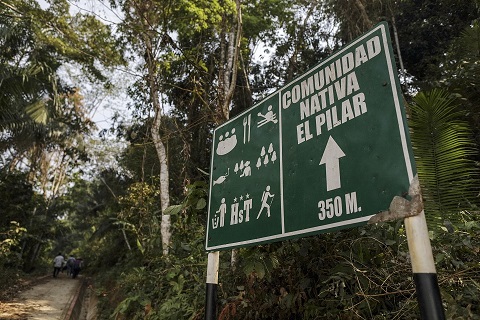
Jorge Palacios Cusurichi is president of the native community of Pilar in Madre de Dios. As part of his community’s Plan de Vida, he is raising fish. He is one of several people who take care of about 1,400 young fish in a fish farm. The ultimate goal is to expand the farms, raise healthy fish and contribute to the economy of the community. It’s an alternative to mining. The community is also growing fruits and vegetables.
“The fish are not contaminated. It is true that 10 or 20 years ago in the rivers and streams, there was an abundance of fish. Right now, there is a fish crisis,” Jorge says. “We’re planting corn, cassava and bananas more than anything. The banana is produced here without fertilizer, without anything, and it produces a hundredfold. We sell it and there is still some left over for our pocket and for our children’s education.”
Other Plan de Vida projects involve ecotourism, crafts, reforestation efforts and other agroforestry projects. They are ways to grow a community’s sustainability.
“Plan de Vida is very important because it helps the community work in an organized manner. This fish farm project has united the community more because we know it’s for the benefit of all,” Jorge says.
But the Plan de Vida projects also encourage dialogue about land control, begin discussion about rights and responsibilities and resolve conflicts in the community.
“The mining conflict in Madre de Dios is not only the miner’s conflict because it doesn’t only affect them. It affects the farmers and the indigenous communities. What we are looking for is that these protagonists talk, dialogue, negotiate and reach an agreement. We achieve that level playing field by strengthening these groups,” says Tattiana.
Mining is an ancestral activity. It is passed down through the generations. There are monuments dedicated to mining, and it contributes to about 80 percent of the economy. But the illegal mining that is done today in protected areas and without consistent regulation is not the mining that was done years ago. Today, the environment and the people are paying a price.
“The economy here in Madre de Dios is so entrenched and so dependent on mining. Without a genuine investment in a more diversified economy, their lives will continue [to depend] on mining. It’s the easiest and most cost effective revenue for the government, for the industry,” says Joseph. “Mining is not going to go away, but there are ways, measures and positive steps we can take forward to try and clean it up.”
One alternative diminishes the amount of mercury pollution when gold is extracted. It’s called “clean gold.”
Jaime Llamosas sells something that is called a radiometric table. He says the technology has been around for about 200 years, but it has been perfected. Instead of mercury, the table uses water and a shaking motion to separate and pull the gold out. The tables are starting to be used by miners.
“We saw the need that the tables be portable. The jungle has no roads. So, therefore it had to be a very, very light table so it could be carried, even shouldered, by anyone and taken to the place of operations,” says Jaime.
“Using technology can generate a change. I see it as an opportunity. I see it as an opportunity for us to change minds, including the government’s, but, above all, the miners. What interests the miner at the end of the day is if he has money to meet his needs. We show them by performing responsible mining they not only will have the money they have now, but also their environment will not be affected. They also will be able to bring dignity to the work they do,” says Tattiana.
“The people who are going to convince the miners to change their way of working are the miners themselves.” – Tattiana Cotrina
Miner Ceriaco definitely seems the promise of the table.
“Not a trace of mercury is used anymore. The gold dust is lifted up, and in this case we no longer need mercury. Mining is demonized by mercury. They say we are making diseases in ourselves. That’s why we urgently need these tables,” says Ceriaco.
And statements like these fill conservationists and scientists, like Cesar, with hope.
Getting miners like Ceriaco on board is really key because after you look at everything, the success of reclaiming the diversity, the fullness and the future of the Amazon all comes down to the people who live there and see the issues every day.
“We all see the integral human development that has to do with all the activity and with all human beings. We cannot exclude anyone. And if there are problems we must seek solutions. As someone said, ‘If one is part of the solution, it is because one is part of the problem,” Cesar says.
“I have a lot of hope for Madre de Dios.” – Cesar Ascorra
In a way, the struggles and work in the Amazon are a great example of an environmental “Plan de Vida” for the entire world. The challenges and successes now in Madre de Dios show what can be done on a larger scale starting with just a community, a community that has a strong plan.
“Start at the local level. Empower communities to have a voice in their environment, in how their economy develops and constructively build a way forward,” says Joseph. “Communities shift that paradigm and say, ‘We have a part to play. We have a voice. We have a role in changing this situation and we’re protagonists in this story.”
Powers. And right action is freedom
From past and future also.
For most of us, this is the aim.
Never here to be realised;
Who are only undefeated
Because we have gone on trying.
-From Four Quartets by T.S. Eliot
In Peru, people are migrating by answering the call of the South American gold rush. They’ve been PULLED into climate change and have become key players in the fight to stake a claim in the Peruvian Amazon. But there’s always a flip-side. Find out how people are being PUSHED by climate change and other factors to migrate in search of safety and economic opportunity in Chad and Bangladesh.
HOW YOU CAN HELP

